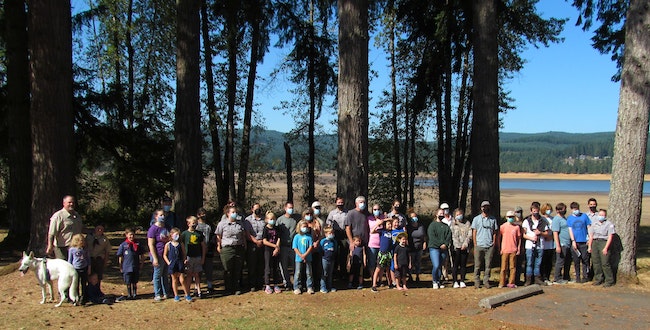 DANA MERRYDAY/CHRONICLE PHOTO Residents came out Saturday to support National Public Lands Day by planting trees and shrubs.
DANA MERRYDAY/CHRONICLE PHOTO Residents came out Saturday to support National Public Lands Day by planting trees and shrubs.
COTTAGE GROVE – This past Saturday 35 volunteers joined U.S. Army Corps of Engineers Park Rangers to participate in National Public Lands Day at the Pine Meadows Campground on Cottage Grove Lake.
Boy Scouts from Troop 140 of Cottage Grove and Troop 60 in Eugene joined the Al Kennedy’s Conservation Crew, and several families who had signed up for a day of celebrating the national treasure of publicly held lands by planting 93 native trees and shrubs.
It sounds simple, but it’s not just doing some easy digging and dumping a plant in a hole. The ground was hard, rocks and roots impeding progress, the hole needed to be twice as large as the rootball, not too shallow and not too deep. Once the plant had its roots gently fluffed and gingerly set in its hole with the loosened soil, there came the weed cloth, mulch, water, and finally installing a cage to protect it from grazing deer and beavers.
The native plants were chosen for their drought tolerance and especially for their value to wildlife. Chelsie Minor, Army Corps Natural Resource Manager, who organized the project, explained, “People use this campground for three months of the year, but the ecosystem is there for the pollinators, birds, small animals the year round.
 The Fair Family – Jim, right, Monica, back left, Brylee, Brayden, and Roxlynn – said they wanted to help during National Public Lands Day on Saturday, Sept. 25, because they walk their dog in the campground, their “other” backyard. “We feel a part of this land and have participated in the last two year’s NPLD. It’s going to be nice to watch our kids grow and be able to see the plants they planted grow as well,” Monica said.
The Fair Family – Jim, right, Monica, back left, Brylee, Brayden, and Roxlynn – said they wanted to help during National Public Lands Day on Saturday, Sept. 25, because they walk their dog in the campground, their “other” backyard. “We feel a part of this land and have participated in the last two year’s NPLD. It’s going to be nice to watch our kids grow and be able to see the plants they planted grow as well,” Monica said.
“The plants we picked have high value in food for butterflies, bees and have berries, nuts, or seeds for the other animals. We sighted the plants to provide a natural boundary between campsites and as they grow some beautiful privacy will develop.”
Among the species planted were Mock Orange, Blue Elderberry, Douglas Spirea, Choke Cherry, Incense Cedar, White Oak, and Red-flowering Current.
In addition to the usual tool-safety protocols, Covid dictated that masks and family/group division of the work parties were added to the precautions.
The Fair Family – Jim, Monica, Brylee, Brayden, and Roxlynn – live close by and often walk their dog in the campground so they were happy to come and give something back to their “other” back yard. “We feel a part of this land and have participated in the last two year’s NPLD. It’s going to be nice to watch our kids grow and be able to see the plants they planted, grow as well,” Monica said.
The “Rascal” crew out of Creswell, composed of the Oldhams and Ervins and four of their eight grandsons, were proud of their work at their first NPLD. One of the grandkids volunteered that he was used to working because he is part of his family business dealing with wells, pumps, and all things water. They had heard about the project through her job at the Army Corps office and wanted to check it out.
Besides the joy of doing a good deed, a free overnight stay at the campground was offered to participants.
National Public Lands Day is the largest single-day volunteer event in the country. Hundreds of thousands of participants gather on the fourth Saturday of September to help improve our National Forests, wildlife habitats, clean up streams, and be able to enjoy being in our natural paradise of publicly held land. The first one was held in 1994 with three federal agencies and 700 volunteers.
The day of actions has grown considerably since then and is guided by the National Environmental Education Foundation (NEEF). NEEF was founded in 1990 as a congressionally chartered 501-c-3 nonprofit to complement the work of the EPA. One of their core missions is to create opportunities for folks to experience and learn about the environment while also improving the planet’s health.
Our public lands total over 640 million acres, 95% of which are managed by four agencies: The U.S. Forest Service, U.S. Fish & Wildlife Service, The National Park Service, and The Bureau of Land Management (BLM). Federal Lands were first managed by the General Land Office under the Treasury Department, which instead of preserving these lands for future generations, were tasked with giving them away to entice settlers to move west, and that accelerated with the passing of the Homestead Act. It was only after it was realized that forests were being denuded, fish and game populations were dwindling, and that especially beautiful areas should be preserved for all, that this philosophy began to change. This led to establishment of the aforementioned federal agencies to manage different aspects of our natural resources.
Back at Pine Meadows, once all the crews had completed their tasks and the tools gathered, there was a socially distanced group photo with masked smiles and a lot of pride in helping make the world a bit better. Before breaking up, Minor thanked the volunteers and emphasized how essential they are to maintaining public lands. “We really enjoy getting you out to enjoy your land and help make it a bit better. Hopefully you have learned a bit about our native ecosystem today and we invite you back to enjoy seeing what you have done over the years.”








